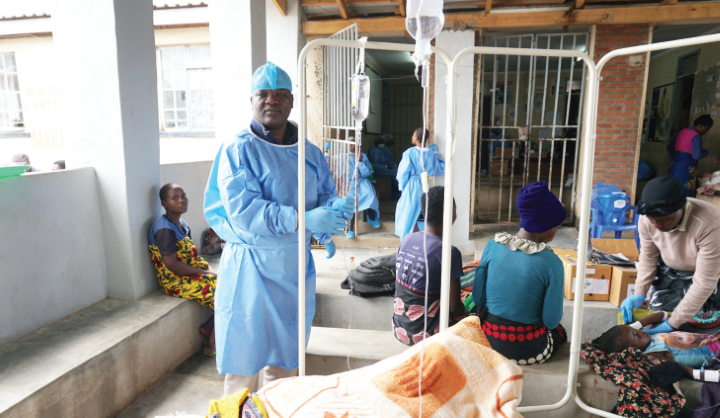Offering hope to malnourished children
 Floods have this year mercilessly hit Mangochi again, thereby threatening thousands of lives with hunger, which in children may lead to malnutrition.
Floods have this year mercilessly hit Mangochi again, thereby threatening thousands of lives with hunger, which in children may lead to malnutrition.
As heavy rains pounded the district and waters washed away houses, livestock and crops in the fields, Anne Kapena, 34, was in Mangochi District Hospital’s Children’s Ward.
She was in the hospital with her one-and-a-half old nephew.
“His mother is at home taking care of another child of hers who is three months old. I brought the boy to the hospital because he kept on vomiting and losing weight,” said the aunt.
The boy lay feeble on the hospital bed, his eyes almost buried inside their sockets, cheeks sagged, his whole body thin and part of the skin on his legs looking variegated.
“Before coming here, the colour of his skin was changing from dark to light brown, but now it is slowly going back to its original colour,” said Kapena.
She admitted that back home, the family routinely eats nsima with vegetables and sometimes porridge seasoned with groundnuts flour. But at the hospital, the child is receiving highly nutritious food called chiponde (peanut butter).
“Chiponde is vernacular for our Ready to Use Therapeutic Food [RUTF], which is a carefully prepared food for children with severe acute malnutrition,” said Linda Trigu, production manager at Project Peanut Butter.
It is one of the few manufacturers of this food supplement. Chiponde is made from peanut paste, sugar, skimmed milk powder, palm oil, mineral and vitamins and an emulsifier, which is mono and diglycerides suitable for infant formula, she added.
So, the sick boy at Mangochi District Hospital has changed from surviving on nsima and vegetable provided at his home to the one mentioned above.
“Since he started eating this, I have noted significant change,” said Kapena, who was by the boy’s bedside, turning him from side to side as he was too weak to turn himself.
Mangochi District Hospital director Dr. Ethwako Mlia said acute malnutrition is life threatening. As such, he said the hospital set aside Tuesday as a day when malnourished children get special treatment, specifically designed to encourage people to go to the hospital and return to their communities on the same day.
It is only serious cases such as this boy which are admitted to the hospital for supervision as they receive chiponde.
“We see an average of 15 to 20 people a day, but the numbers differ according to season; in some seasons the figures go up to 40. Mangochi has a population of about 900 000 people,” said Mlia.
Catherine Mkangama, a senior technical adviser in the Ministry of Health, said due to interventions such as early case identification, promotion of breastfeeding and provision of chiponde, deaths associated with malnutrition are decreasing.
But poor cultural practices such as barring pregnant women from eating nutritious foods such as eggs threaten the gains being made.
“At national level, 41 percent of children under the age of five are stunted and that is too high. Stunting leads to mental retardation and poor physical growth,” Mkangama said, adding that stunted growth is one aspect of malnutrition.
There are more stunted children in the Southern Region, at 48 percent, followed by the Centre, 47 percent and the North 45. Male and rural children are more likely to be stunted, according to the 2010 Demographic Healthy and Survey (DHS).
“Education and wealth are both inversely related to stunting levels. Stunting decreases with increasing levels of the mother’s education. More than half of children born to mothers with no education are stunted (53 percent) compared with 48 percent of the children born to mothers with a primary education and 39 percent of children born to mothers with a secondary education,” the DHS indicates.
According to information from a project called Wellness and Agriculture for Life Advancement Programme (Wala), chronic malnutrition rates in Malawi are among the highest in the world, and malnutrition is among the immediate causes of child deaths.
Government and partners such as the United States government are running programmes aimed at curbing malnutrition. As a sign of commitment, the US Ambassador to the UN Food and Agricultural Agencies (FAO) David Lane was in the country.
He toured several intervention projects, including the one at Mangochi, and promised to report the situation back to the US government for possible remedies.
“I have seen that this is saving the lives of babies,” he said.
As reflected in the DHS, the population of stunted children in the country has decreased from 53 to 47 percent, wasting (another form of malnutrition) has reduced to four from six percent, and underweight has gone down to 13 from 17 percent.
Such gains, however, are threatened by natural calamities such as the floods in Mangochi, climate change as it is also associated with unreliable rains and floods, which continue to wash away people’s gardens, crops and livestock. All these have a negative impact on people’s access to food.
United States Ambassador to Malawi Jeanine Jackson expressed her concern over the levels of malnutrition and indicated that the fight against malnutrition requires concerted efforts from local communities and professionals.





